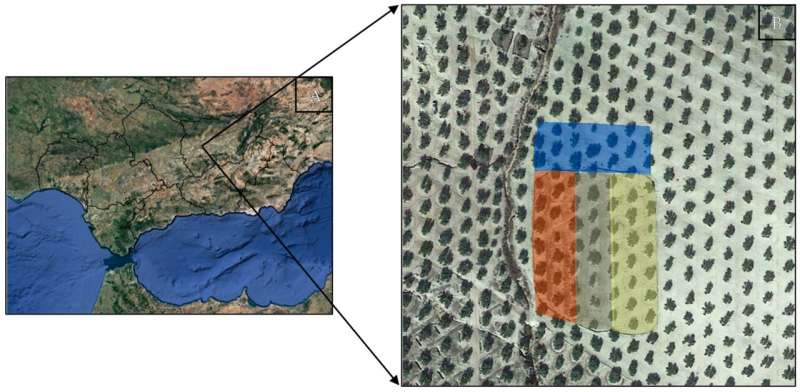Location map pf Andalusia region (A); aerial view of experiemental treatments (B); conventional tillage (blue, saffron (orange), oats (gray), and lavender (yellow bars). Credit: Horticulturae (2022). DOI: 10.3390/horticulturae8070618
Compared to conventional practices and bare soil, plant covers generated by intercropping between the alleys of olive groves increase carbon sequestration and reduce soil losses due to erosion.
Agricultural soils play a fundamental role against climate change by favoring carbon sequestration and the sustainability of agroecosystems. However, due to traditional farming practices, many soils of olive groves in the Mediterranean zone present a high level of degradation with losses in fertility and productivity, a high level of erosion, or poor water retention capacity. A study, now published in Horticulturae and developed within the European Diverfarming project, has shown that plant covers improve the quality of the soils by increasing their organic matter content (and thus increasing carbon sequestration), improving the structure (which improves the water retention capacity) and decreases erosion.
For that reason, the SUMAS research team from the Department of Agricultural Chemistry, Edaphology and Microbiology at the University of Córdoba (UCO), directed by the Professors Luis Parras and Beatriz Lozano, applied intercropping in olive groves in Torredelcampo (Jaen). They included alternative crops such as lavender, saffron, oats, or vetch in rotation in the olive grove alleys. As opposed to conventional management, which disturbs the surface soil layer and applies chemical herbicides and fertilizers, and compared to no-tillage with herbicides, which keeps the soil completely bare, intercropping is presented as a practice that improves soil quality.
But this improvement "is not only due to the intercropping, but is also due to the cover and the canopy it generates," explains Manuel González-Rosado, researcher at the UCO, who took part in the study. "For the team it was essential to keep the soil of the olive grove covered with crops which would later generate lasting organic residues. Ultimately, it is interesting to generate canopies which cover the alleys of the olive grove and which avoid the major problem faced by Andalusian olive groves, which is the loss of soil due to erosion and runoff," he added.
A surface crust is generated when the soils are bare, and problems arise because it prevents water from filtering into the soil, and increases erosion rates and carbon losses. In this way, intercropping and the plant covers avoid the soils being exposed to torrential rains or to high temperatures. According to González-Rosado, "Therefore, the key is to keep the soil covered."
Soil is currently at the center of European policies in the struggle against climate change. For that reason, changes are needed in the ways soil is managed so that it becomes a source of carbon sequestration and avoids CO2 emissions.
More information: Manuel González-Rosado et al, Crop Diversification Effects on Soil Aggregation and Aggregate-Associated Carbon and Nitrogen in Short-Term Rainfed Olive Groves under Semiarid Mediterranean Conditions, Horticulturae (2022). DOI: 10.3390/horticulturae8070618
Provided by University of Córdoba























